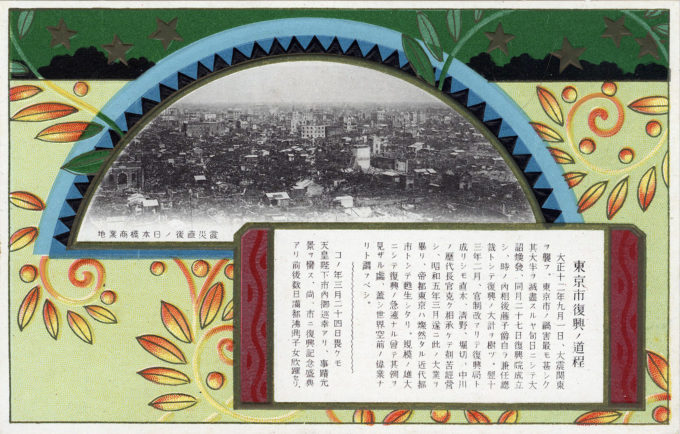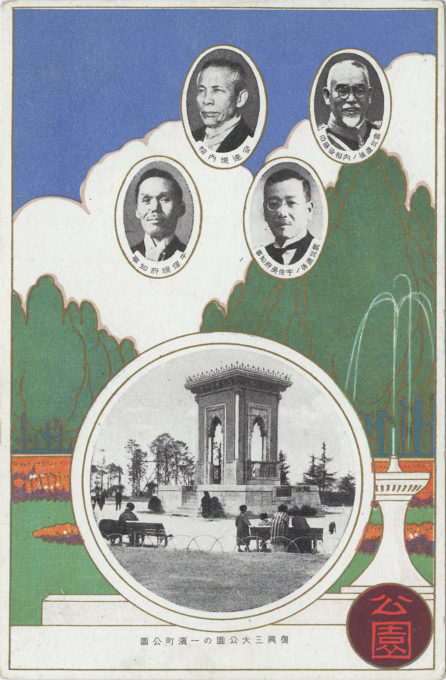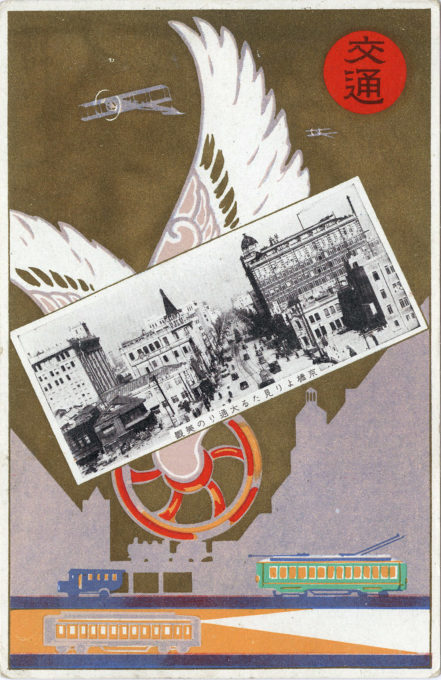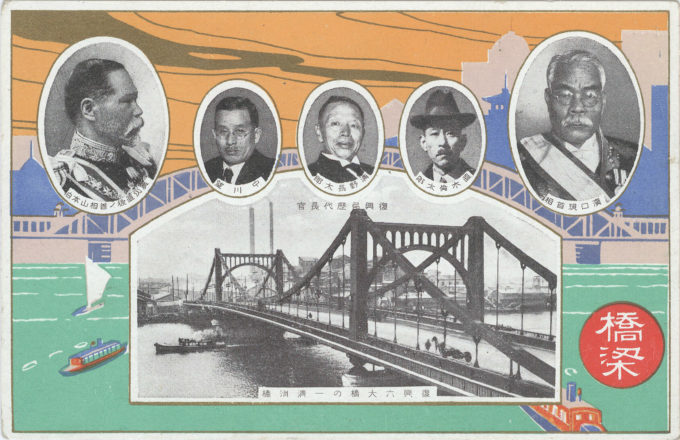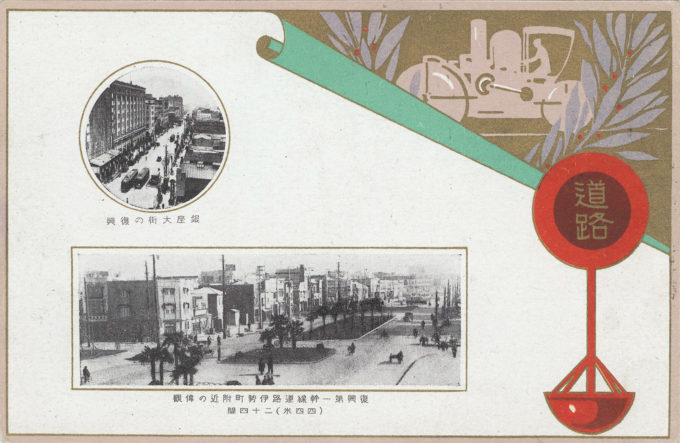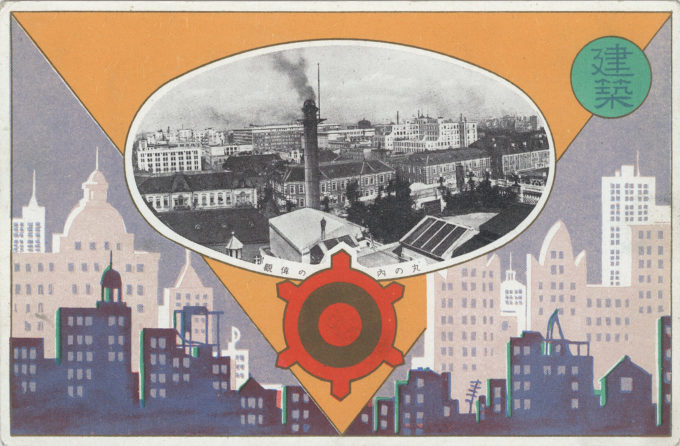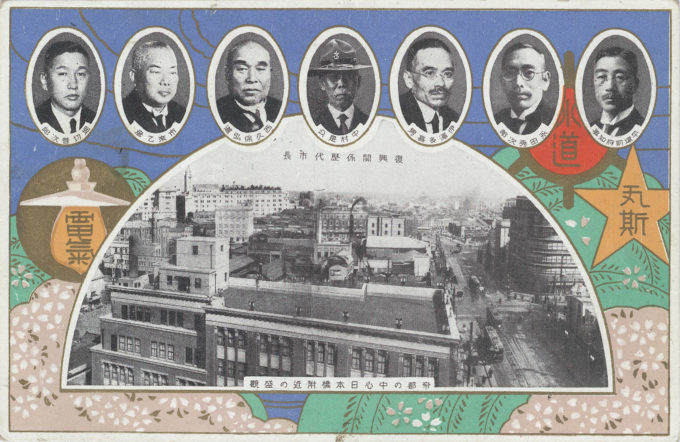
Imperial Capital Reconstruction Board members, c. 1930. Looking north toward Nihonbashi Bridge. Shirokiya department store is on the right; Mitsukoshi department store is in the distance in the upper left. The president of the Imperial Capital Reconstruction Board, Goto Shinpei, the former mayor of Tokyo and then-current Home Minister, is seen in the middle inset photo (wearing a Boy Scout campaign hat as he was also the first chairman of the newly organized [1922] Boy Scouts of Nippon).
See also:
Post-earthquake Bridge Construction, Tokyo, c. 1932.
Showa Emperor Tours Rebuilt Tokyo, 1930.
“In September 1923 Tokyo was devastated by the Great Kanto Earthquake. The fires caused by the earthquake burned the city center to the ground. Over 140,000 people were reported dead or missing, and 300,000 houses were destroyed.
After the earthquake a city reconstruction plan was formulated, but because the projected costs exceeded the [entire] national budget only a small part of it was realized.”
– Tokyo Metropolitan Government
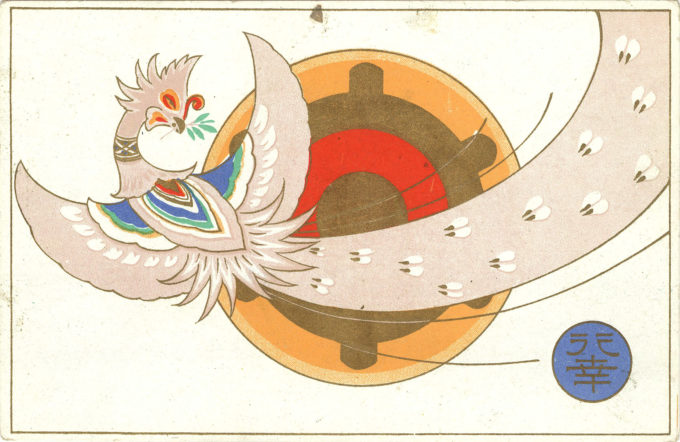
Imperial Capital Reconstruction Commemoration, c. 1930. Tokyo, and its predecessor Edo, had risen Phoenix-like from previous conflagrations and natural disasters. Fires were common enough in feudal times to be poetically termed “Flowers of Edo”. Previous to the 1923 Great Kanto Earthquake, Tokyo had experienced widespread damage from devestating fires (1872, 1914) and floods (1910).
“The earthquake caused extensive damage in Tokyo and Yokohama, with roughly 140,000 killed or missing, over 44 per cent of the urban area of Tokyo destroyed by fire and some 73.8 per cent of all households affected.
“Almost all the old, densely populated central areas of Tokyo that had been commoner areas during the Edo period were destroyed by fire. Of the old ‘low city’ of Tokyo, almost nothing remained, while in the former samurai areas in the foothills to the west, the ‘high city’, few fires were seen.
“… The day after the earthquake while fires were still burning, Goto Shinpei was reappointed Home Minister as part of the cabinet of Yamamoto Gonnohyoe, a non-party prime minister appointed by the Genro after the earthquake to establish a national unity government to deal with the crisis. Goto was the logical choice as he already had experience as Home Minister, and had subsequently been mayor of Tokyo from 1920 to 1922 … Goto saw the earthquake as a golden opportunity to carry out the restructuring of Tokyo into a moden city and proposed the creation of a national government agency that could carry out the project under the direct supervision of the Home Ministry. The Imperial Capital Reconstruction Board (Teito Fukko-in) was established on September 19 by cabinet order with Goto as president.
“Tokyo City Recovery Path”, Imperial Capital Reconstruction Commemoration, c. 1930. The Reconstruction Board has its work cut out for it. Forty-eight percent of all homes in Tokyo Prefecture (the homes of 397,119 families) were either destroyed or classified as uninhabitable as a result of the Great Kantō Earthquake and fires. Out of the City of Tokyo’s 2.26 million inhabitants, 1.38 million were rendered homeless by the disaster. Nearly 7,000 factories met with destruction. In the City of Tokyo alone, 121 bank head offices out of a total 138 were destroyed. What meager social welfare facilities that had existed before the earthquake to provide services to the poorest Tokyo residents were also annihilated by the disaster – 162 hospitals and 117 out of Tokyo’s 196 primary schools likewise suffered ruin.
- Imperial Capital Reconstruction Commemoration, c. 1930. The Parks Reconstruction Committee. Before the 1923 earthquake, parks land comprised just 1.7 per cent of Tokyo’s urban space. By 1930, that area had more than doubled to 3.7 per cent. Seen here is Hamacho Park, in Nihonbashi Ward.
- Imperial Capital Reconstruction, c. 1930, commemorating transportation reconstruction. It took years to restore streetcar service across the most affected areas of the city. Reconstruction marked the beginning of the end of streetcars in Tokyo and the creation of bus routes to replace them.
- Imperial Capital Reconstruction Commemoration, c. 1930. The Bridges Reconstruction Committee is pictured above Kiyosu-bashi, erected in 1928 across the Sumida River, one of Tokyo’s 97 new or rebuilt main spans to replace those destroyed by the Great Kanto Earthquake.
- Imperial Capital Reconstruction Commemoration, c. 1930. Road reconstruction included the creation of wide boulevards to act as firebreaks. Ginza Owari is seen in the circular inset; below, the first of the completed firebreaks, in the old Tokyo neighborhood of Ise-cho.
“… Carried out over the seven years from 1924 to 1930, the reconstruction project successfully modernized the central areas of Tokyo and provided much of the basic infrastructure that has supported Tokyo’s growth until the present.
“The project established a rational network of primary, secondary and teritary roads through the central city area of Tokyo totalling 253 kilometres in length. These included Showa Avenue with a width of 44 metres running from Shinbashi to Ueno through the centre of the old town, and in all 52 major new arteries were built in the old city of over 22 metres in width and totalling 114 kilometres in length.
“Some 121 public schools were rebuilt in fireproof materials, many of which are still in use today and were designated shelter areas in case of earthquakes and fires. Some 55 parks were built totalling about 42 hectares in area including many in areas of the old city that had virtually no open space, and other built as playgrounds adjacent to schools.
Imperial Capital Reconstruction Commemoration, c. 1930. An elevated view of the Marunouchi business district, looking north toward Marunouchi Londontown, Tokyo Central Station and the Marunouchi Building.
“An interesting innovation given the tight constraints on space was to create mini pocket-parks at each end of almost all the rebuilt bridges as sitting places with trees and planters for the use of local residents. The project also reconstructed over 400 bridges in steel, and generalised the provision of sidewalks which had previously been virtually unknown in Japanese cities.
“In March of 1930 ceremonies were held to celebrate the completion of the Imperial Capital Reconstruction Project. Leaders of the project were tremendously proud of their achievement, and published that year a two volume, 1,874-page set of documents commemorating the project as well as a small volume in English in order to show the world their achievement.”
– “The Making of Urban Japan: Cities and Planning from Edo to the Twenty First Century”, by Andre Sorensen, 2005


